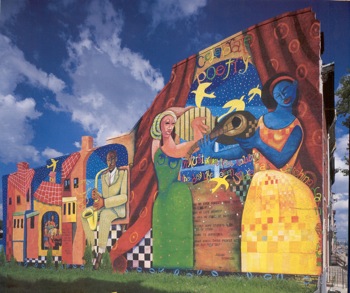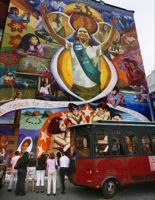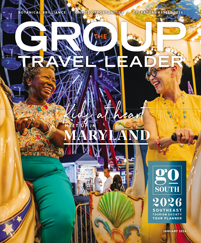
When Karl Schutz and his wife visited Romania in the early 1970s, they were impressed by murals about religious history painted on the outside walls of local monasteries.
“They attracted huge amounts of tourists from all over the world,” said Schutz. “We though it would be worthwhile for Chemainus.”
However, it would be another decade before Schutz could convince local leaders in Chemainus, British Columbia, about the merits of his idea. When the local sawmill announced it was closing, the economically depressed town looked around for ways to revive itself, and there were Schutz’s murals.
Five murals were painted on the walls of downtown buildings in 1981 and “promoted as an outdoor art gallery.” They were a hit, attracting many visitors to the Vancouver Island town. Today, Chemainus is recognized as the pioneer of a movement that has spread to more than 100 communities in five countries, where large murals present fascinating public art; teach a lesson in local history, culture and heritage; and draw in tourism dollars.
“We are recognized as the first town to use murals as an economic development strategy,” said Schutz.
He said the secret to a successful mural arts program is twofold: the subject and the artist.
“Definitely the successful ones are done by highly educated artists, professionals, who create very unique paintings that really are works of art,” he said. “And you have to find something of interest to most people.
“When people come and visit another country or another city, everybody is interested in their history. Most of the murals are based on the history of the town, which gives an advantage. Every town’s murals are totally different.”
The following handful of cities and towns have successful mural programs that meet Schutz’s criteria of professionalism and local interest.
Chemainus, British Columbia
There are now 42 murals in Chemainus that trace the history of the town from the area’s native Indians through the first white settlers and the town’s heyday as a lumber and milling center.
“It starts with the native Indians, then the Europeans and the forestry industry,” said Schutz. “It shows how they logged with oxen at first and then steam donkeys, and from there to trains and how logs were shipped from the harbor around the world by sailing ships.
“They range from 5-by-5 to more than 100 feet long. It depends on the building.”
Some of the murals use the trompe l’oeil method of painting that creates a realistic, almost three-dimensional effect. Some add to the realism with actual items, such as the real boardwalk and stairs that seem to be part of a painting of the small Victorian house that served as the town’s first telephone switching office.
New murals are occasionally added — a native artist has been hired for this year — and their scope has expanded to include all of Vancouver Island and to feature the works of noted Canadian artist Emily Carr.
Three companies offer a variety of tours of the murals with professional actors as guides.
www.muraltown.com
www.chemainus.com
Philadelphia
The largest mural program in the country is in Philadelphia, where more than 3,000 murals adorn the sides of buildings throughout the city.
 |
| Courtesy Philadelphia Mural Arts Program |
The 25-year-old Mural Arts Program began as an effort to combat graffiti and morphed into its current incarnation that generates more than 100 new murals a year and operates an art education program for at-risk youth.
The subjects deal with the cultures of local neighborhoods. “We get into the neighborhoods that make Philadelphia the cultural melting pot that it is,” said Ryan Derfler, tour manager for the Mural Arts Program. “The people and cultures are reflected in the murals.
“You go into South Philly and the Italian market area and see a Frank Sinatra mural. It is very different in West Philly. You see murals based on the people who live there.”
The program operates a variety of mural tours, including walking tours and tours on an antique trolley. The program also provides step-on guide service along routes specifically designed for large motorcoaches. There are two guides, one for the narration and one to act as a navigator for the driver.
“The mural tour is the best way to learn about the city and the people who live here. It is living history,” said Derfler. “You see topics that are relevant to the past 25 years but speak to the history of those people.”
www.muralarts.org
(215) 685-0754
Ely, Nev.
Like Chemainus, Ely faced economic hard times in the late 1990s when the local mine closed.
“A couple of people heard about Chemainus and the great success it had, and the people bought into it,” said Ed Spear, director of the White Pine County Tourism and Recreation Board. “The first mural was by the man who owns the former jailhouse.”
 |
| Courtesy White Pines Chamber of Commerce |
More than two dozen murals are now on Ely buildings. “All the murals have to be around our history and heritage,” said Spear. “The theme is where the world map became one.”
“Miners were recruited from around the world,” said a guide who leads tours of the murals. “When they started to meld into a community was when their kids started school together.”
The largest mural, which stretches for more than 100 feet and stands more than 30 feet tall, is United by Our Children, which depicts the faces of five children representing the world’s ethnic races with an American flag in the background. The faces are those of actual children from Ely.
www.whitepinechamber.com
(775) 289-3720
Frederick, Md.
The city of Frederick took an unusual step in beautifying a flood control project through downtown and a drab concrete bridge that spanned it. And their efforts generated some unexpected criticism.
Local artist William Cochran and several assistants spent five years painting the bridge in the trompe l’oeil technique to make it look like it was made of stone.
A visitor stopped by the visitors center to complain that she couldn’t imagine why the city would allow vines to grow on the painting. It turned out that the realistic-looking vines were part of the painting.
In addition to vines and more than 3,000 stones, none if which are alike, the bridge contains a bronze gate, a sculpture in a niche, a marble fountain and numerous symbols suggested by the local community.
“There are hundreds of symbols painted into the bridge,” said Tiffany Ahalt, tourism marketing manager for the Frederick Tourism Council. “Every time I go down there, I notice a new symbol I was not aware of before.”
The bridge is part of Carroll Creek Park, which also includes landscaping, benches, an amphitheater, old-fashioned lampposts, several distinctive pedestrian bridges, shops and restaurants.
“When Mr. Cochran started, it was pretty much undeveloped — just flat concrete pads,” said Ahalt. “Now it is a great little park. It is a nice place for people to just go and relax.”
There are three other downtown murals. “People seem to enjoy them as much as the bridge,” said Ahalt. “They are included on our typical step-on-guide tour of the historic area. They are also painted trompe l’oeil.”
The Delaplaine Visual Arts Center, located in a former grain mill, is adjacent to the bridge. Ahalt said the center, which has restrooms and a gift shop, makes a good place for groups to meet their step-on guides.
www.fredericktourism.org
(301) 600-4050
Pine Bluff, Ark.
Visitors to Pine Bluff can step back in time and pretend they are part of one of the city’s 13 murals.
The first mural, completed in 1992, depicts the city’s Main Street in 1888. A small stage in front of the mural allows visitors to put themselves on the same level as the dusty dirt street in the painting.
“The public has been very enthusiastic” about the murals, said Susie Madsen, director of visitor and group tour information for the Pine Bluff Convention and Visitors Bureau. “They are all in the downtown area painted on the sides of different businesses. All are done by internationally known muralists.”
Madsen said plans call for an eventual 22 murals as funds allow.
Among local natives honored by the murals, which depict scenes from Pine Bluff’s history, are Willie Hocker, the designer of the Arkansas state flag; Broncho Billy Anderson, one of the first great cowboy movie stars; and Saracen, a Quapaw chief who rescued stolen white children from another Indian tribe.
www.pinebluffcvb.com
(870) 536-7600











